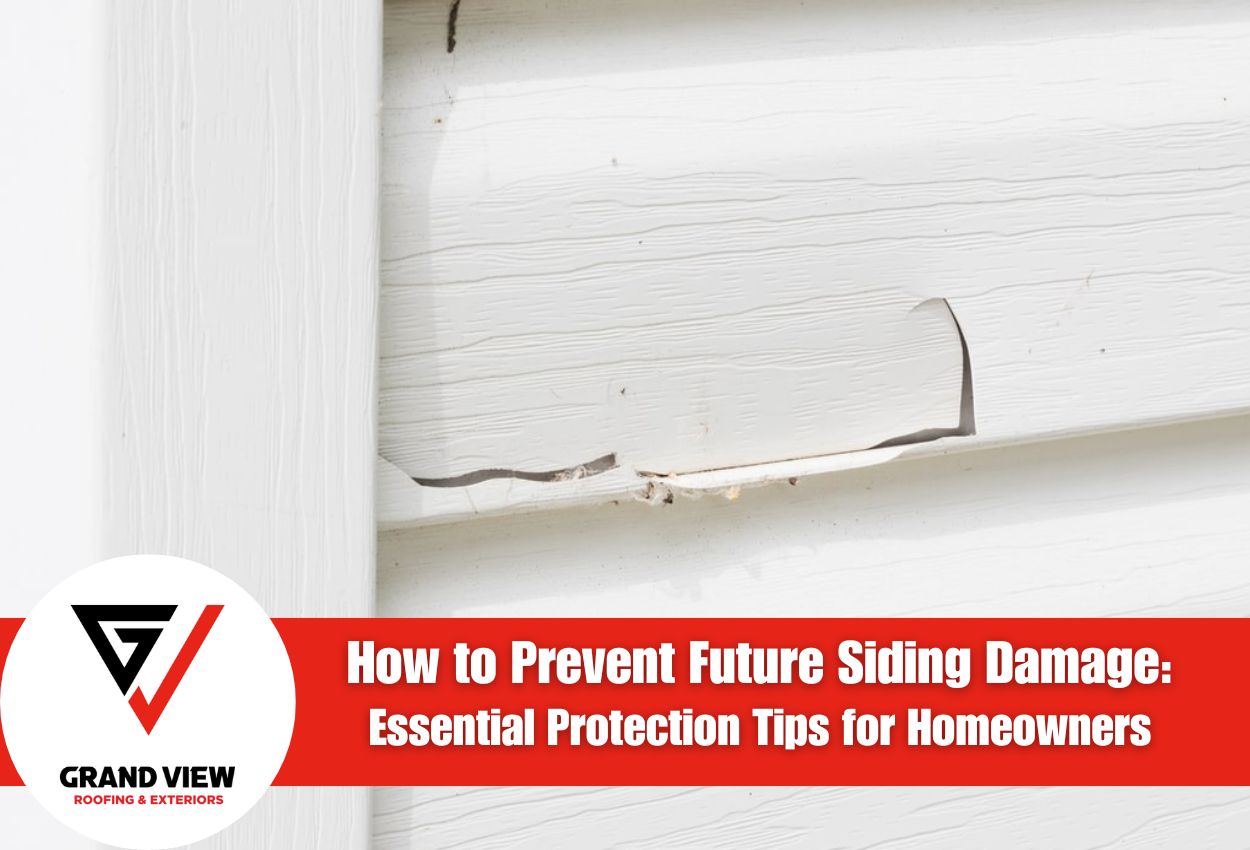The weather challenges in South Jersey can take a serious toll on exterior siding. From harsh coastal winds to freezing winter temperatures and humid summers, these environmental factors accelerate wear and tear on your home’s protective outer layer. Recognizing the specific vulnerabilities of your siding material is the first step toward effective damage prevention that extends its lifespan and maintains your home’s curb appeal.
Siding materials respond differently to South Jersey’s climate. Vinyl siding, popular for its affordability, can crack during winter freezes or warp under intense summer heat. Wood siding, while beautiful, requires vigilant protection against moisture damage and insect infestations that thrive in humid coastal environments. Fiber cement offers durability but still needs maintenance to prevent moisture intrusion at seams and edges.
Regular siding inspections and maintenance not only preserve your home’s appearance but also prevent structural damage. When small issues go unaddressed, they often lead to significant repairs or premature replacement. Understanding these vulnerable points allows homeowners to implement targeted solutions, saving both time and money while keeping their home’s exterior strong against South Jersey’s challenging weather.
Regular Cleaning Routines That Extend Siding Life
Establishing consistent cleaning routines is essential for maximizing your siding’s lifespan and preventing expensive damage. Each siding material requires specific care techniques. Vinyl benefits from gentle washing with a soft-bristled brush and mild soap solution, while wood siding needs careful cleaning to avoid saturation damage. For all materials, avoid high-pressure washing, which can force water behind panels and create moisture problems.
South Jersey’s humid climate creates perfect conditions for mold, mildew, and algae growth on siding panels. These organisms don’t just create discoloration — they actively break down siding materials and can lead to serious structural issues if left untreated. A simple cleaning solution of water with white vinegar or oxygen bleach effectively removes these growths without harsh chemicals that might damage landscaping.
Damage prevention is always more affordable than repairs. Trimming trees and shrubs to prevent contact with siding lowers the risk of trapped moisture and mold development. Ensuring proper drainage around your home’s foundation also protects lower siding panels from water damage. Many South Jersey homeowners find that scheduling bi-annual cleanings, typically in spring and fall, provides the ideal maintenance frequency to catch potential problems before they require professional intervention and helps maintain your home’s exterior year-round.
Proper Landscaping to Minimize Siding Damage
Strategic landscaping isn’t just about curb appeal — it’s a crucial defense mechanism for your home’s siding. When planning your garden beds, maintain a minimum 2-foot gap between plants and your home’s exterior. This buffer zone prevents moisture retention against siding surfaces and allows adequate airflow. Choose plants with non-invasive root systems and avoid species that attract wood-boring insects, especially if you have wood siding. For South Jersey homes, consider drought-resistant native plants that require less watering, reducing splash-back that can deteriorate lower siding panels.
Trees and shrubs require regular maintenance to prevent them from becoming hazards to your siding. Trim branches to maintain at least 3 feet of clearance from all exterior walls. This prevents scratching during windy conditions and eliminates pathways for pests to access your home. Overhanging limbs should be pruned back to prevent leaves and debris from collecting in gutters, which can lead to water overflow and siding damage. In South Jersey, seasonal trimming is especially important before winter storms that could cause branches to snap against your home.
Remember that while visual appeal matters, protective landscaping practices significantly extend your siding’s lifespan by preventing moisture accumulation, physical damage, and pest infestations. A well-designed landscape that balances beauty with spacing creates the ideal environment for maintaining your home’s exterior for years to come.
Addressing Water Management to Protect Your Investment
Effective water management is one of the most critical factors in preventing premature siding damage. Your home’s gutter system is the first line of defense against water infiltration. Clogged or damaged gutters can overflow during South Jersey’s heavy rainstorms, sending cascades of water down your siding and saturating the material. Clean gutters at least twice yearly, especially after fall leaf drop, and inspect for proper slope to make sure water flows freely toward downspouts.
Downspout placement and extension are equally important considerations. Downspouts should deposit water at least 5 feet away from your foundation to prevent it from splashing back onto lower siding panels. Splash blocks or flexible downspout extensions can disperse water safely away from your home. For properties with persistent drainage issues, underground drain pipes or dry wells might provide more permanent solutions to protect your siding.
The grading around your foundation directly impacts siding performance. Properly sloped soil should direct water away from your home at a rate of approximately 1 inch of drop for every foot of distance. After heavy rains, inspect your property for standing water near the foundation, which indicates grading problems. Adding soil to create the right slope or installing French drains can resolve these issues before they lead to serious siding damage. Remember, addressing issues with your water management system proactively extends siding lifespan and protects both the exterior and structure of your South Jersey home.
Seasonal Inspection Checklist for Early Problem Detection
Developing a seasonal inspection routine dramatically improves your ability to catch siding damage before major repairs are needed. In spring, carefully examine your home’s exterior for winter damage. Look for cracked or loose panels, separation at seams, and areas where caulking has failed. Check the north side of your home carefully, as moisture may have caused damage during freeze-thaw cycles common in South Jersey winters. Check for warped or buckled sections that indicate potential water infiltration behind the siding.
Fall inspections should focus on preparing your home for winter challenges. Examine all siding for color fading or chalking, which signals weathering and decreased protection. Inspect around windows and doors where shifting can create gaps in siding. South Jersey’s coastal influence means salt exposure may accelerate corrosion on fasteners. Look for rust streaks or loose panels that need securing before winter winds arrive.
Summer and winter bring their own threats to siding integrity. During summer, check for sun damage including blistering, excessive fading, or brittleness, specifically on south-facing walls exposed to intense UV radiation. Winter inspections should prioritize ice dam formation along rooflines that can force water behind siding panels. After severe weather, perform additional checks focusing on areas where wind-driven rain or debris may have compromised your home’s siding.
Professional Maintenance Worth the Investment
While many siding maintenance tasks can be handled by homeowners, professional services typically deliver superior results. Expert washing techniques use calibrated equipment that effectively removes buildup without damaging siding materials — a delicate balance that DIY attempts often fail to achieve. Professional inspections can also identify early signs of moisture intrusion or structural weaknesses that untrained eyes might miss. For wood siding, professional treatments with specialized sealants and preservatives provide significantly longer protection than consumer-grade products, extending lifespan by years rather than months.
When selecting a South Jersey contractor for siding maintenance, verify their specific experience with your siding material. Ask potential contractors about their inspection process, maintenance techniques, and what preventative treatments they recommend for homes in our coastal climate. Request proof of insurance, proper licensing, and examples of past maintenance work. Qualified professionals should provide references from local homeowners with similar siding types and be willing to explain how their services address South Jersey’s specific weather challenges.
The investment in professional siding maintenance typically pays for itself through extended material lifespan and prevention of repairs. Most South Jersey homes benefit from professional maintenance every two years, supplemented by regular homeowner care between visits. This approach maintains your home’s protection while keeping maintenance costs predictable throughout the changing seasons.
Immediate Action Steps for Minor Damage to Prevent Major Problems
When you notice small issues with your siding, taking fast action can prevent full replacements down the road. For loose vinyl panels, secure them immediately using appropriate replacement clips or nails designed specifically for siding applications. Small cracks in vinyl or fiber cement can be sealed with exterior-grade caulk that matches your siding color. Address nail pops by carefully removing the protruding nail and replacing it with a properly sized siding nail in a new location about an inch away from the original hole, then seal the old hole with caulk.
After severe weather events common to South Jersey like nor’easters or heavy thunderstorms, perform emergency temporary repairs to minimize further damage. For partially detached sections, secure them temporarily with corrosion-resistant screws until permanent repairs can be made. Cover any exposed areas with heavy-duty plastic sheeting or tarp, securing it with staples or temporary strips to prevent water infiltration.
Keep basic siding repair supplies on hand for these situations: weatherproof caulk, replacement clips, corrosion-resistant nails, matching touch-up paint, and plastic sheeting. Documenting damage with photographs before making temporary repairs is essential for potential insurance claims. Taking care of these small issues immediately extends your siding’s lifespan and prevents the cascading effect of damage that often begins with seemingly insignificant problems.
Protect Your Home with Grand View Roofing & Exteriors
Understanding the intricacies of siding maintenance can seem daunting, but taking proactive steps is necessary to safeguard your property. At Grand View Roofing & Exteriors, we specialize in protecting your home against the unpredictable South Jersey weather, ensuring your siding withstands the test of time. Don’t wait for minor wear and tear to turn into expensive repairs. Regular maintenance and professional assessments can significantly prolong the life of your siding, saving you money and enhancing your home’s curb appeal.
Ready to take the next step in protecting your investment? Call Grand View Roofing & Exteriors at (856) 305-9883 to schedule a consultation and learn more about our tailored siding solutions. Let us help you prevent future siding damage with our expert services.





 Call Us Today - (856) 305-9883
Call Us Today - (856) 305-9883 
